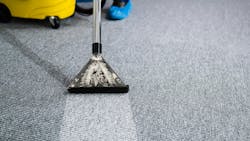Why Having a Clean Building Matters—For Employees and For Customers
As anyone who’s ever worried over their outfit for a job interview or a first date can surely attest, presentation matters—and if it matters for individuals, it also matters for buildings and facilities. For building managers, one of the primary reasons to maintain the cleanliness and upkeep of their space is because appearances speak volumes, both to employees and to customers.
Simply put, investing in tidy facilities can have a big impact on how people relate to the space—and a careful approach to cleanliness may result in improved productivity from employees as well as heightened customer satisfaction.
How Cleanliness Helps Boost Office Efficiency
One of the essential responsibilities of any building manager is to maintain an environment where employees are unencumbered to work productively and efficiently—and investing in overall cleanliness can make a huge impact.
Part of this pertains to health and wellness. When dust and debris are left to accumulate on desks, saturate carpeting or circulate through the air conditioning system, it can exacerbate allergies and other respiratory conditions. When employees consistently feel under the weather, their productivity suffers.
The link between cleanliness and productivity goes beyond airborne allergens. Germs also accumulate on surfaces such as doorknobs and in communal bathroom spaces. Without rigorous attention to cleaning and sanitizing, bacteria can spread—and so can illness. Again, more sick days inevitably means diminished productivity.
In addition to physical well-being, a clean office environment can also promote mental well-being. In other words, managers who present their employees with a clean and tidy environment demonstrate a real investment—they’re spending real time and money to ensure a comfortable and pleasant place to work. Employees who feel invested in tend to work with greater confidence and a higher level of morale.
Cleanliness and Customer Service
If the cleanliness of a facility can affect employees, it also has a significant impact on how customers perceive the building.
Remember that first impressions are everything—and when a commercial building is visibly clean, the impression it creates is one of reassurance. Customers and clients will naturally feel more welcome in an environment that seems fresh and clean—and that sense of welcome not only facilitates a favorable impression, but a greater willingness to linger or return.
A clean building doesn’t only convey that customers are welcome—it also reflects positively on the business owner and the team members who work there. Keeping an office facility tidy and organized is one of the best ways to signal professionalism and attention to detail, two qualities that can burnish the reputation and foster a deeper sense of consumer trust.
The bottom line: Appearances matter, and when an office building or storefront appears clean, it helps build credibility—helping employees and customers alike know they’re being cared for.
Taking a Strategic Approach to Office Cleanliness
Of course, maintaining the cleanliness of a commercial space goes well beyond haphazard vacuuming or dusting shelves on an as-needed basis. Taking a more strategic approach is key—and while specifics can vary from business to business, some general guidelines include:
- Keeping a schedule is imperative. Some tasks will need to be done multiple times each week (like vacuuming), while others are only needed once or twice a year (like deep cleaning the carpets). Setting a formalized schedule in place ensures nothing slips through the cracks.
- Some areas will need to be prioritized more than others. Specific areas that warrant particular concentration include high-traffic areas such as employee break rooms, conference rooms, bathrooms, and entryways.
- It’s important to invest in the right cleaning supplies, steering clear of harsh or toxic cleaning agents that might actually degrade materials over time—in essence, doing more harm than good.
- While the bulk of the cleaning work will fall to facilities teams, all employees should know where to find emergency cleaning supplies in the event of a spill—and facilities managers should ensure these supplies are well-stocked and accessible.
- Remember that many cleaning tasks can be done in-house, but others may require the expertise and specialized equipment of a third-party vendor. Deep cleaning the carpets is a good example of this.
- Speaking of equipment, keep in mind that vacuums, mops and other cleaning implements may require maintenance of their own—and eventually, they will lose their efficacy and need to be replaced. Equipment monitoring is key.
Cleanliness is about more than sanitation—it’s about building trust and creating a space where employees thrive and customers feel confident. For facilities teams, it’s important to be strategic in building that trust, both among employees and customers.
About the Author
Ed Quinlan
Ed Quinlan is the president of Chem-Dry. Since 1970, Chem-Dry has used their proprietary carbonating method to deliver a deep, long-lasting clean to carpets. Cleaning more than 10,000 household carpets daily, Chem-Dry is widely known for their expertise in stain and pet odor removal. Chem-Dry also makes professional-grade carpet cleaning products, ideal for deep cleaning in both residential and office environments.
